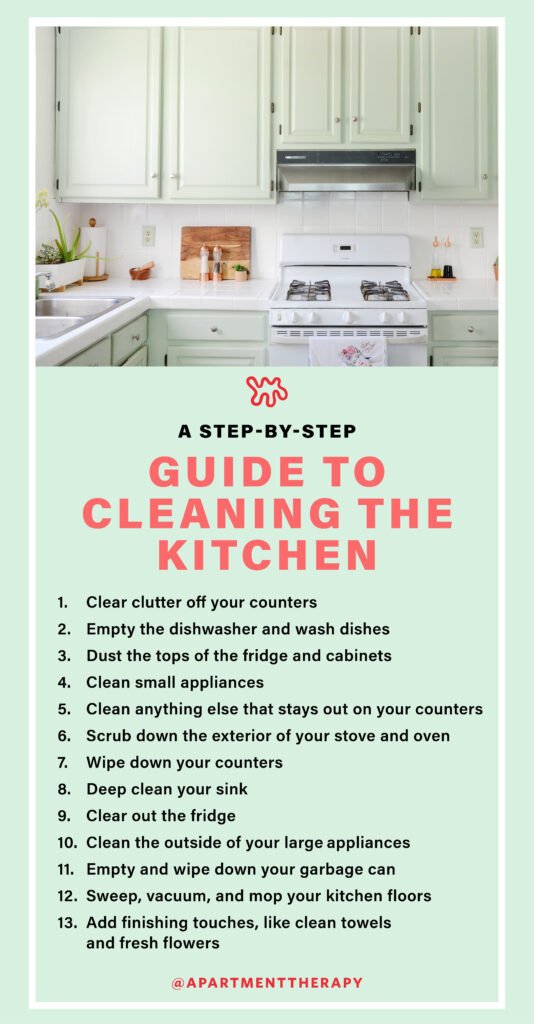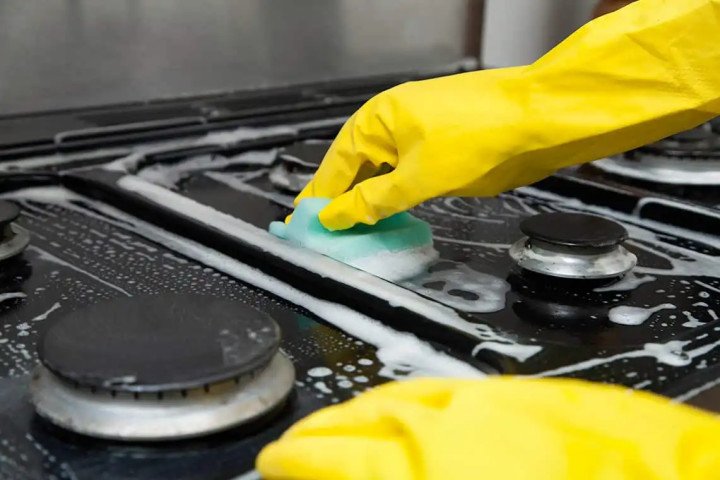
In this article, we will guide you on the proper maintenance and cleaning of your kitchen appliances. We’ll provide you with tips and tricks to keep your appliances in their best condition, ensuring their longevity and efficiency. From regular cleaning routines to specific maintenance tasks for different appliances, you’ll learn everything you need to know to keep your kitchen running smoothly. So let’s get started and make sure your kitchen appliances shine and perform their best!

This image is property of www.redfin.com.
A Guide to Properly Maintaining and Cleaning Kitchen Appliances
When it comes to keeping your kitchen running smoothly, proper maintenance and regular cleaning of your appliances are key. From your major appliances such as the refrigerator, oven, and dishwasher, to smaller appliances like the coffee maker, blender, and toaster, each appliance requires specific care in order to prolong its lifespan and keep it functioning at its best. In this guide, we will explore the different types of kitchen appliances, their proper maintenance, cleaning tips, and some troubleshooting techniques for common issues.
Different Types of Kitchen Appliances
Major Appliances
Major appliances are the backbone of any kitchen. They are typically larger in size and are essential for performing daily cooking and cleaning tasks. The major appliances you’ll find in most kitchens include the refrigerator, oven, and dishwasher.
Small Appliances
Small appliances, on the other hand, are handy tools that assist with various tasks in the kitchen. They are usually compact and portable, making them easy to use and store. Coffee makers, blenders, and toasters are some examples of small appliances commonly found in kitchens.

This image is property of cdn.apartmenttherapy.info.
Proper Maintenance for Major Appliances
Refrigerator
Proper maintenance of your refrigerator is crucial for keeping your food fresh and preventing any breakdowns. Start by cleaning the interior shelves and drawers regularly using a mild detergent and warm water solution. Avoid using abrasive cleaners that can damage the surface.
Next, check and clean the condenser coils at least twice a year. These coils are responsible for cooling the refrigerator and can get clogged with dust and debris over time. Use a brush or vacuum cleaner to gently remove any buildup.
Lastly, maintain proper temperature settings and avoid overloading the refrigerator as this can hinder the airflow and cause the appliance to work harder than necessary.
Oven
Keeping your oven clean not only ensures better cooking results but also prevents potential fire hazards. Start by removing any food spills or debris from the oven cavity after each use. You can use a damp cloth or sponge with a mild detergent to wipe away any residue.
For tougher stains or baked-on grime, create a paste using baking soda and water. Apply the paste to the affected areas and let it sit for a few hours. Then, scrub the stained areas using a nylon brush or sponge. Rinse with water and wipe dry.
Regularly check and replace any faulty oven seals or gaskets to maintain proper heat insulation and prevent energy wastage.
Dishwasher
To keep your dishwasher functioning efficiently, it is important to clean and maintain it regularly. Begin by removing any food particles or debris from the dishwasher filter. Most modern dishwashers have removable filters that can be easily cleaned using warm water and a soft brush.
Next, inspect the spray arms for any clogs or blockages. If you notice any buildup, use a toothpick or a small wire to clear the openings. Additionally, run an empty cycle with a dishwasher cleaner once every few months to remove any residue or odors.
Monitor the condition of the door seal and replace it if you notice any cracks or leaks. A faulty door seal can result in water leaks and reduced cleaning performance.
Cleaning Tips for Major Appliances
Refrigerator
To clean the exterior of your refrigerator, use a mild all-purpose cleaner and a soft cloth. Avoid using abrasive cleaners or scrub brushes that can scratch the surface. Pay special attention to the handle and control panel areas, as they are frequently touched and prone to fingerprints and stains.
It is also important to defrost your refrigerator regularly if it does not have an automatic defrost feature. Excess frost buildup can hinder the efficiency of the appliance and reduce its cooling capabilities.
Oven
Aside from regular cleaning, it is beneficial to perform a deep clean of your oven at least once or twice a year. Start by removing the oven racks and soaking them in warm, soapy water. Scrub away any residue using a non-abrasive sponge or brush.
For the oven cavity, remove any loose debris and apply a commercial oven cleaner according to the manufacturer’s instructions. Make sure to wear gloves and work in a well-ventilated area. Leave the cleaner on for the recommended time and then wipe away the dissolved grime using a damp cloth.
Dishwasher
To keep your dishwasher smelling fresh, run a cycle with a cup of white vinegar placed in the top rack. Vinegar helps to remove any odors and residue that may have built up in the interior.
Occasionally, remove the bottom rack and inspect the drain area. Clear away any food particles or debris that may be blocking the drain. Use a small brush or toothbrush to dislodge any stubborn buildup.

This image is property of www.thespruce.com.
Proper Maintenance for Small Appliances
Coffee Maker
To maintain the quality and performance of your coffee maker, it is important to clean it regularly. Start by removing and cleaning the filter basket and pot after each use. Rinse them with warm, soapy water and allow them to air dry.
To descale your coffee maker and remove any mineral deposits, fill the water tank with equal parts white vinegar and water. Run a brew cycle without coffee grounds, and then repeat with a cycle of clean water to rinse away any vinegar residue. Wipe the exterior of the coffee maker with a damp cloth and dry thoroughly.
Blender
After each use, disassemble your blender and clean the detachable parts with warm, soapy water. Pay close attention to the blade assembly, as it can accumulate food residue. Use a brush or sponge to gently scrub away any leftover ingredients. Rinse and dry all parts before reassembling the blender.
Toaster
To keep your toaster clean and functioning properly, unplug it and remove the crumb tray regularly. Dispose of any accumulated crumbs and wipe the tray with a damp cloth. Clean the exterior of the toaster with a soft cloth and mild detergent. Avoid using abrasive cleaners that can damage the finish.
Cleaning Tips for Small Appliances
Coffee Maker
Besides regular cleaning, it is a good idea to deep clean your coffee maker every few months. Fill the water reservoir with a mixture of equal parts water and white vinegar. Run a brew cycle without coffee grounds. Repeat this process twice with clean water to remove any vinegar residue.
To freshen up the exterior, wipe it down with a damp cloth and a mild cleaner. Make sure to dry the coffee maker thoroughly before using it again.
Blender
For stains that are difficult to remove, fill the blender jar halfway with warm water and a few drops of dish soap. Secure the lid and blend the mixture for a few minutes. Rinse the jar thoroughly and allow it to air dry before storing.
Toaster
To remove crumbs trapped in the toaster slots, turn the toaster upside down over a sink or garbage can and gently shake it. For a more thorough cleaning, use a small brush or toothbrush to dislodge any stubborn crumbs.

This image is property of www.cleanipedia.com.
Overall Cleaning and Maintenance Practices
Safety Precautions
When cleaning or maintaining your kitchen appliances, it is important to prioritize safety. Always unplug the appliance before cleaning, and never immerse it in water unless specifically recommended by the manufacturer. Use caution when handling sharp or hot surfaces, and follow all instructions and warnings provided by the appliance manufacturer.
Regular Cleaning Schedules
To prevent the buildup of dirt, grime, and bacteria, it is essential to establish regular cleaning schedules for your kitchen appliances. Set aside specific days or times each month to deep clean your appliances, and make it a habit to wipe down surfaces and clean detachable parts after each use. By incorporating regular maintenance into your routine, you can ensure that your kitchen appliances work efficiently and provide optimal performance.
Cleaning Supplies and Techniques
Natural Cleaning Solutions
Many kitchen appliances can be effectively cleaned using natural cleaning solutions. Baking soda, vinegar, and lemon juice are all versatile and eco-friendly options that can tackle tough stains and odors. They are also gentle alternatives to harsh chemicals, which can be harmful to both your appliances and the environment.
Basic Cleaning Techniques
When cleaning your kitchen appliances, start with a mild detergent or cleaning solution and a soft cloth or sponge. For stubborn stains or grime, use a non-abrasive brush or scrub pad. Avoid harsh chemicals or abrasive cleaners that can damage the surface or remove the appliance’s protective coating.

This image is property of www.cleanipedia.com.
Specific Cleaning Challenges
Removing Stains and Odors
Stains and odors can be stubborn to remove, especially on kitchen appliances that are frequently used. For challenging stains, create a paste using baking soda and water. This paste can be effective in lifting stains from stainless steel surfaces, plastic parts, and even oven interiors. For odors, vinegar and lemon juice are great natural deodorizers. Wipe the affected area with a cloth soaked in vinegar or lemon juice, and allow it to sit for a few minutes before rinsing.
Dealing with Grease Buildup
Kitchen appliances, especially ovens and range hoods, can accumulate greasy residue over time. To tackle grease buildup, start by wiping away any loose debris with a damp cloth. Next, apply a degreaser or a mixture of dish soap and warm water to remove the remaining grease. For particularly stubborn grease, use a non-abrasive scrub brush or sponge to agitate the area. Rinse with clean water and dry thoroughly.
Troubleshooting Common Issues
Identifying Common Problems
Sometimes, kitchen appliances can encounter common issues that affect their performance. Noisy refrigerators, malfunctioning oven thermostats, and dishwashers with poor cleaning results are some of the problems you may encounter. In such cases, refer to the appliance’s user manual or contact the manufacturer for specific troubleshooting steps.
Simple DIY Fixes
Certain minor issues with kitchen appliances can be resolved with simple DIY fixes. For example, a refrigerator not cooling properly may simply need a thorough cleaning of the condenser coils. A dishwasher with drainage problems might be due to a clogged filter or drain hose. By identifying and addressing these common issues, you can potentially save on repair costs and extend the lifespan of your appliances.
Conclusion
Taking care of your kitchen appliances is essential for their longevity and optimal performance. By following the proper maintenance and cleaning guidelines outlined in this guide, you can ensure that your appliances remain in top condition. Regular cleaning, preventive maintenance, and troubleshooting can help you address common issues and keep your kitchen running smoothly. Remember to always prioritize safety, use the recommended cleaning supplies, and consult with the manufacturer or a professional if you encounter any major problems. With proper care, your kitchen appliances will serve you well for years to come. Happy cooking!






